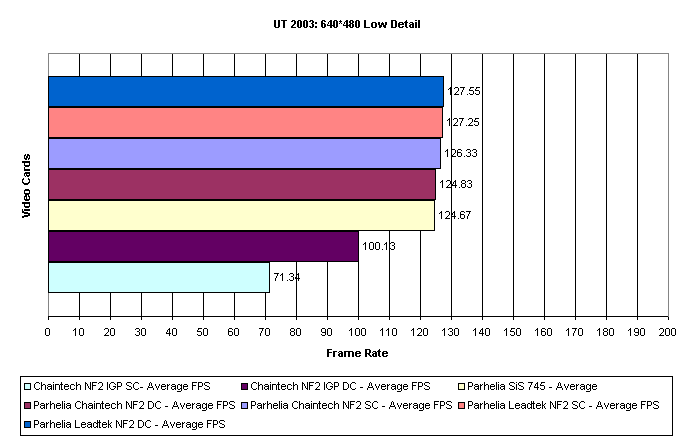The Truespace benchmark used the same process mentioned in my previous article using the following settings, the image was then rendered to 1600*1200. The DivX tests took the video from the DVD of "The Hitchhiker's Guide to the Galaxy" (NSTC) which equaled 8555 frames without any audio being encoded. For the TMPGEnc test we took the same video, but added its audio and ran used the settings shown here. For the DUMeter tests, we took about 3GB of files (about 3000 files) ranging in size from a couple of KB's to a couple of hundred MB's. We sent the data to and from the system using, in the case of the network cards, a 10/100 switch and the master network card was the Gigabit NIC on the MSI 845PE. So let us see how this motherboard performs compared to other motherboards and other video cards.
Gaming/Networking Benchmarks
Unreal Tournament 2003
This game has some of the best graphics of current games, and as such is very stressful, both on the CPU and the Video card. So the test we are running is at 640*480 so that the video card is taken out of the equation, at least as much as it can. So how does the motherboard work compared to other systems?

We can see that apart from the integrated graphics of the Chaintech nForce 2 motherboard the performance difference between the three motherboards is about 2.3%. This shows little differences in motherboards, and looking at the two nForce 2 boards there isn't that in the way of difference between the motherboards, about 1% or less. Compared to the SiS 745 based motherboard there is only a 2% difference, which isn't much. Overall the difference can be put down to all the random variables that appear in tests.
Jedi Knight II
Based on the Quake III engine, this game has been shown to use most of the available memory bandwidth given to it. So how does the Dual channel nForce 2 chipset do here? Lets see...

Here we see a difference start to make an appearance. The SiS based chipset provides about 84 fps average, while the lowest nForce 2 (non-integrated) score is about 8fps extra. The Leadtek motherboard does better than the Chaintech motherboard, by about 7fps which is pretty good considering that the difference between a older chipset and the current high end chipset is about the same.
Networking Tests
A device that is becoming much more common currently is the network card. Many people are using cable or DSL internet, and as such more than one computer need to be connected to each other. This has also brought about the sharing of files and for the business professional who has been using a network for years to make backups, speed is something that is needed and appreciated. So how does the nVidia network card fair in our tests?

For the networking portion of the test we see a difference in the two systems. The Leadtek version has a better download speed than the Chaintech motherboard, but the reverse is true with the uploading test. The firewire card had a better upload speed. The limits of the upload speed may be due to the 4.3GB Quantum hard drive (ATA33) that was the boot drive. Since games are only one area that people use their computers, what about some of the other facets of the computer user.
Other Benchmarks
Truespace 4.2 3D Rendering
3D rendering has become a growing hobby for many, and in some cases the faster that a image can be rendered the better the picture and the quicker that you can make the rendered images. So how does Truespace perform with the nForce 2 platform, as this is a 'beginners' program but still has most of the quality of the larger programs.

What can we see with the Leadtek motherboard compared to the other two comparison motherboards? While the Leadtek motherboard is the 'fastest' motherboard here, it takes the lead by just over 1% or well within the margin of error for the tests. Compared to the SiS chipset the Leadtek motherboard is 4.5% faster, or about 1 render per hour faster.
VirtualDub 1.4.10
DivX video has become one of the best ways of encoding any type of video, with its high compression and pretty good quality, it has allowed for capture and video to small spaces while still maintaining high quality video. DivX has also become very CPU dependent and as such faster CPU's render video much closer to real-time. But how does the Leadtek motherboard perform in this intensive benchmark when we render at 720*480?

We notice that just as with 3D rendering the Leadtek offering isn't that much faster than the comparable Chaintech offering. However in this benchmark the dual channel nature of the nForce 2 motherboard shows for one of the first times a benefit. There is a 1.8% increase with dual channel being enabled, though this can also be explained as being within the error range of the tests. When compared to the SiS 745 based motherboard there is really a vast improvement, between a 17% and 20% increase in rendering speed. What happens when we render video to a DVD compatible format?



